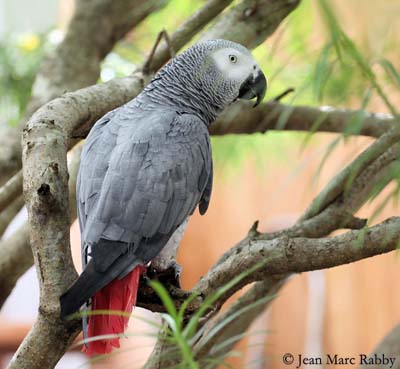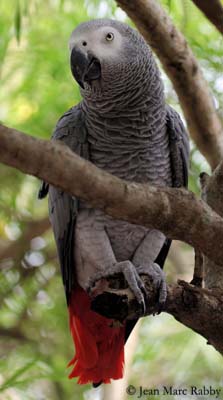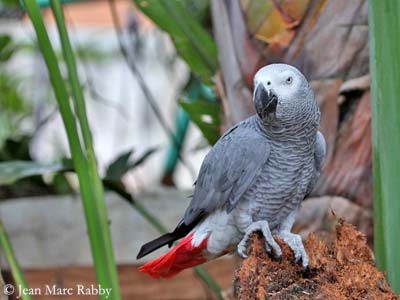
Grey Parrot
Psittacus erithacus
Psittaciforme Order – Psittacidae Family
BIOMETRICS:
Length: 28-39 cm
Weight: 400-490 g
LONGEVITY: Up to 73 years
DESCRIPTION:
The Grey Parrot is a common cage bird. This species is known as domestic pet since several centuries. These parrots figure on Egyptian hieroglyphs and several civilisations kept also Grey Parrots as pets. This parrot accompanied the Portuguese sailors during their long crossings over the seas.
Grey Parrot adult male is a stocky parrot. Body plumage is grey with paler edges giving heavy scaled effect, mainly on head, neck, back and breast. Wings are darker grey with blackish primaries. Uppertail coverts and tail are bright red.
On the underparts, the grey scaled effect of the breast extends onto paler grey to whitish on belly and vent. Undertail feathers are red.
Head is scaled white and paler, with bare white facial skin including cere, lores and wide eye-ring. The strong, hooked bill is blackish. Eyes are pale yellow. Legs and feet are grey to darker grey.
Both sexes are similar.
Immature has red tail with darker tips and grey eyes.
DIET:
Grey Parrot feeds on fruits and seeds. It depends mainly on oil palm for food, only eating the oily flesh, not the nut.
It also damages maize crops, feeding in cultivated areas in large flocks.
PROTECTION / THREATS / STATUS:
Grey Parrot is locally abundant. However, this species is threatened by destruction of the forests, and mainly by the loss of the tall nesting trees.
Grey Parrot is also the most trapped parrot for pet-trade, which is considered as the cause of the decline of this species. From common in recent past, the Grey Parrot is now locally common in its range, to relatively rare in some parts of the range.
Fr: Perroquet jaco
All : Graupapagei
Esp : Loro Yaco
Ital : Pappagallo cenerino
Nd : Grijze Roodstaartpapegaai
Russe : Серый попугай
Photographe :
Jean Marc Rabby
Des Ailes et des Plumes
Texte de Nicole Bouglouan
Sources:
HANDBOOK OF THE BIRDS OF THE WORLD volume 4 by Josep del Hoyo, Andrew Elliot and Jordi Sargatal – LYNX EDICION – ISBN 8487334229
PARROTS OF THE WORLD – An Identification Guide – by Joseph M. Forshaw – Princeton University Press – ISBN 0691092516
BirdLife International (BirdLife International)
Wikipedia (Wikipedia, The Free Encyclopedia)

BEHAVIOUR:
Grey Parrot feeds on fruits and seeds. It depends on the oil palm for food, but it only eats the oily flesh, not the nut. It seems to be more attracted by red fruits than others. When they feed in maize crops, the large groups often damage the plantations.
Grey Parrot is a gregarious species. They are very noisy when they gather in large flocks at nighttimes’ roosts. They sleep together in tall trees such as raphia palms often at forest edges, but also on small islands in the middle of streams or inland lakes.
They leave the roost at sunrise in small flocks. They join their feeding areas flying high in the sky. They come back to the roost following usual regular routes, and this return lasts until after dusk.
Grey Parrot feeds in different manners. It often feeds high in the canopy, but it can be seen on the ground where it takes clay and mineral soil.
Grey Parrot is resident in its range, and moves according to the production of fruits by particular trees’ species. It travels short distances between the roost and the feeding area.

FLIGHT:
Grey Parrot flies fast with direct flight. Its wing beats are rapid and shallow.
REPRODUCTION:
Breeding season varies according to the region.
Grey Parrot nests in cavity, usually a hole situated high in tall tree. This species is usually solitary nester, but sometimes, two or three nests can be found in the same tree.
Female lays 2 to 3 white eggs. Incubation lasts about 21 to 30 days, depending on the intervals between the laying of each egg.
Chicks are fed by both parents. Young fledge about 80 days after hatching.
We find two subspecies:
Psittacus erithacus erithacus has pale grey plumage, cherry-red tail and black bill. It is found in eastern Ivory Coast to western Kenya and north-western Tanzania.
Psittacus erithacus timneh is darker grey. Tail is dark maroon with brownish edges. On the bill, the upper mandible is reddish with black tip. It is found in West Africa, in Sierra Leone to Ivory Coast.
VOICE: SOUNDS BY XENO-CANTO
Grey Parrot utters numerous kinds of sounds, usually high-pitched, such as screams and squawks, but it also gives prolonged whistles. Common sounds are harsh “kraark…kraark…kraark”, sharp “rak-rak-rak-rak” or “kree-aark…kree-aark…kree-aark”.
Grey Parrot is able to imitate the calls of other birds’ species.
HABITAT:
Grey Parrot lives mainly in lowland primary and secondary rainforest. It also frequents edges and clearings, and can be found in mangroves and gallery forest. It feeds in wooded savannahs and cultivated areas. Grey Parrot is visible from lowlands up to 2200 metres of elevation. It is closely associated with oil palms.
RANGE:
Grey Parrot lives in West to Central Africa.
